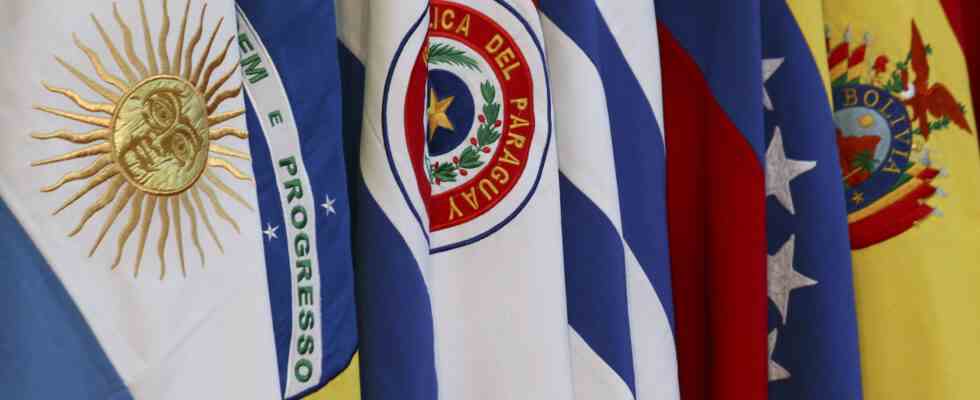FAQ
Status: 01/28/2023 08:46 a.m
The Mercosur economic community has existed for more than 30 years. But the confederation of states is in a crisis, also because free trade agreements are being concluded and not ratified.
The European Union’s free trade agreement with the South American confederation Mercosur has been on hold for months. Chancellor Olaf Scholz is now to revive it on his trip to South America. The region is relevant for the EU because Mercosur is one of the largest economic communities in the world.
What is Mercosur?
Mercosur is an international economic community in southern Latin America. The name is an abbreviation of Mercado Común del Sur. Translated, this means “Common Market of the South”. On November 29, 1991, the community was brought into being by the founding countries Argentina, Brazil, Paraguay and Uruguay.
Chile, Bolivia, Peru, Colombia, Ecuador, Guyana and Suriname have non-voting associated states status. Bolivia is in the accession process.
Venezuela signed its accession on July 4, 2006 and officially joined the confederation in 2012 as the fifth member, but in 2016 the country was suspended by the other states.
Venezuela’s crisis
Venezuela is one of the countries with the largest oil reserves in the world, the country is a founding member of the OPEC cartel. Billions flowed into the Venezuelan economy until the global oil price collapsed in the 2010s. Since then, the country has barely recovered from the severe crisis with hyperinflation in 2018, supply shortages and famine.
Why was Mercosur founded?
The aim of the economic community is to gradually create a common market, expand economic policy coordination, align legislation and promote environmental protection.
This includes, for example, abolishing tariffs in trade between the Mercosur countries and introducing common external tariffs and a common trade policy with third countries. This means that the states had the goal when they were founded to create an internal market with the free movement of goods, services, capital and employees based on the model of the European Union.
How important is the international community?
With more than 260 million consumers, around 62 percent of South America’s population live in Mercosur member states, and 67 percent of South America’s gross domestic product (GDP) is generated there. Mercosur is one of the largest economic communities in the world, but in 2021 it only generated around 3.21 percent of global GDP.
The Mercosur economic area is becoming more and more important for Germany, especially since Russia launched the war of aggression against Ukraine last year: “Countries like Brazil, Chile and also Argentina are extremely predestined,” explained the President of the German Chamber of Industry and Commerce (DIHK), Peter Adria.
German companies are turning “increasingly to Latin America” again, explained the DIHK President. The countries there had a “partially promising industrial infrastructure”.
Will the integration of the Mercosur countries succeed?
So far, however, the economic community has been nothing more than a holey customs union: In an analysis on the 30th anniversary of the ratification of the treaty, the ifo Institute showed that there are still customs duties between the countries for some products and that the trade volume between is no match for the States.
The common external tariff also has numerous exceptions, there is no agreement to avoid double taxation, let alone a coordinated economic policy.
In order to further advance the economic integration of Brazil and Argentina, the two states want to revive the idea of a common currency. The aim is to increase the shrinking volume of trade between the two largest countries in South America – and if successful, other Latin American countries are also to be integrated into a common currency.
Where are the problems?
Above all, there are major differences between the individual member states in economic terms: According to the ifo Institute, Brazil’s economic output accounts for around three quarters of the bloc’s GDP, which means that the state primarily asserts its own interests.
The alliance is also currently suffering from a rift with Uruguay: Lacalle Pou, Uruguay’s president, recently announced that he would open his country to economic relations with China. However, the Mercosur countries are actually prohibited from bilateral relations with third countries.
To smooth things over, Brazilian President Luiz Inácio Lula da Silva said this week that he supports a Mercosur-China deal in a plan to modernize and open up the South American trading bloc to other regions.
What is behind the agreement with the EU?
Negotiations between the EU and the Mercosur countries on a joint trade agreement lasted almost 20 years, and an agreement was reached on June 28, 2019. Not much has happened since then, the agreement has been on hold for three years.
Because part of the agreement is that environmental protection should be strengthened. But because the ousted Brazilian President Jair Bolsonaro was not to be dissuaded from allowing the deforestation of the Amazon rainforest, the agreement has not yet been ratified.
Chancellor Scholz’s trip should now bring movement back into the agreement. And the new Brazilian President Lula da Silva is also pushing for an agreement: “The agreement with the EU is urgently needed.”

